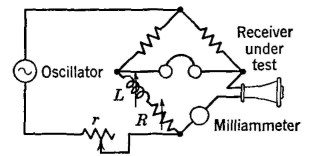| Electrical Communication is a free textbook on the basics of communication technology. See the editorial for more information.... |

|

Home  Electroacoustic Devices Electroacoustic Devices  Input Impedance of Telephone Receivers Input Impedance of Telephone Receivers |
|||






|
|||
Input Impedance of Telephone ReceiversA receiver or a loudspeaker is an electric motor, and information regarding operation can be obtained from input impedance measurements. The data and the discussion in the following pages are for a small low-impedance head receiver. This receiver was resonant at about 840 cycles. Similar tests can be made on other telephone receivers and can also be made on loudspeakers. The results would be somewhat different because some modern receivers and loudspeakers are less resonant. If a receiver is connected to an impedance bridge as in Fig. 25, if the test current indicated by the milliammeter is held constant by rheostat r, and if the resistance R and the inductance L required to balance the receiver impedance at different frequencies are measured, it will be found that these measured values vary greatly with test conditions. If the receiver is radiating sound energy into a small closed box the impedance will be greatly different from that if it is radiating into a large room. Or if the receiver is held to the ear the impedance will be different from that measured if it is radiating into a room. The impedance of a receiver or loudspeaker varies with the acoustic load on the diaphragm.
The vector difference between the normal and the blocked impedance of an electroacoustic transducer such as a telephone receiver or a loudspeaker is defined as the motional impedance1 of the device. This motional impedance is proportional to the back electromotive force induced in the receiver windings by the motion of the receiver diaphragm. The reluctance of the magnetic circuit of a receiver changes with the motion of the receiver diaphragm, and thus the flux linking the receiver coils varies, inducing a back electromotive force in these coils. If the diaphragm is damped, the diaphragm motion is influenced, and thus the induced back electromotive force and therefore the impedance are changed.
|
|||
Home  Electroacoustic Devices Electroacoustic Devices  Input Impedance of Telephone Receivers Input Impedance of Telephone Receivers |
|||
Last Update: 2011-05-30


